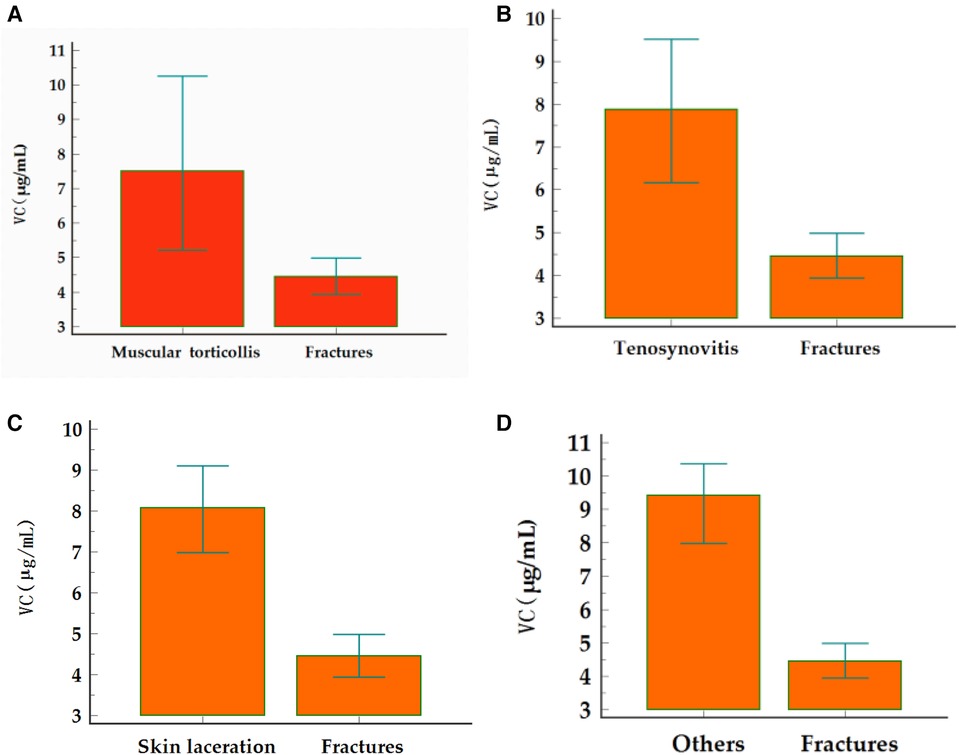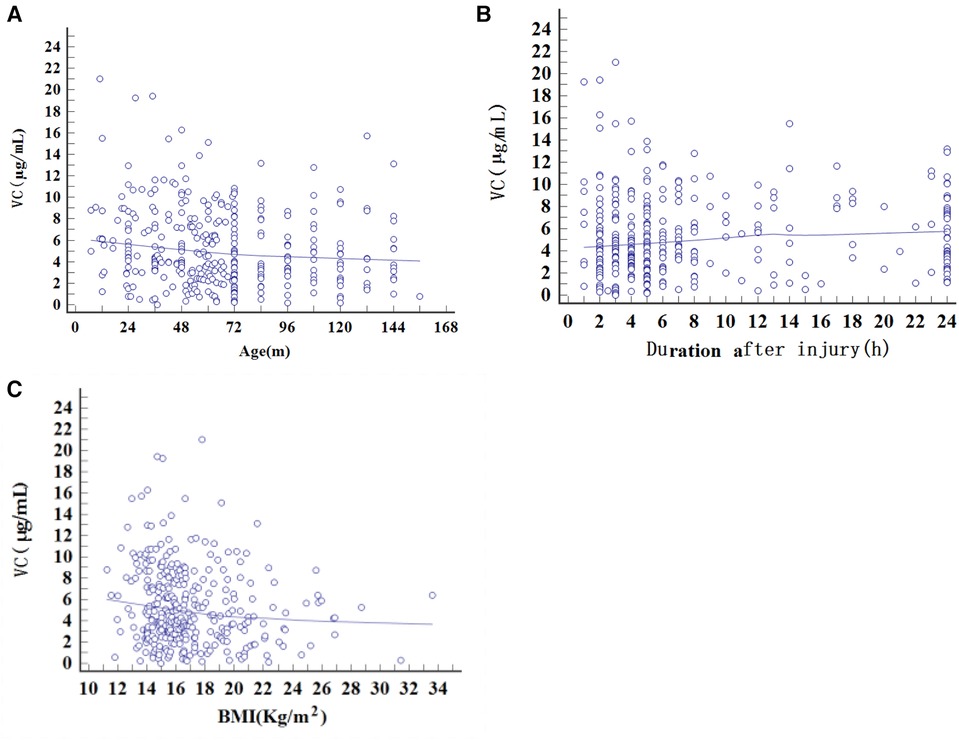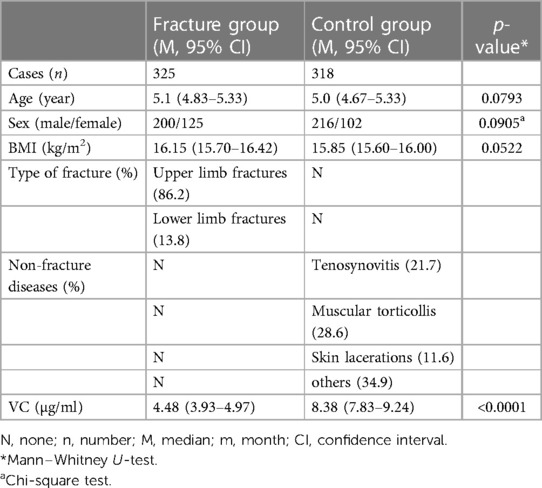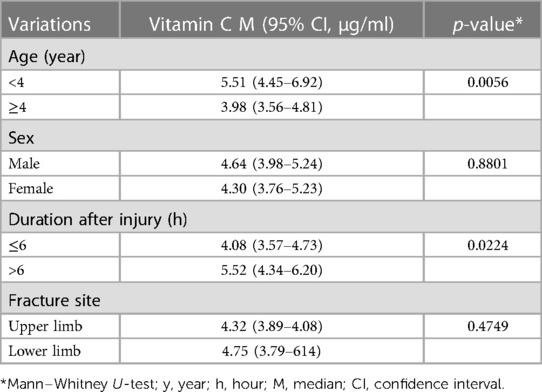- Department of Pediatric Orthopedics, Jinan Children’s Hospital, Jinan, China
Introduction: The role of vitamin C in pediatric fractures has not received much attention, although it is known to be a factor in osteoporotic fractures in the elderly. This case-control study aimed to investigate the changes in serum vitamin C levels among children with limb fractures.
Methods: We recruited 325 children with and 316 children without limb fractures hospitalized between January 2021 and December 2021. Following admission, basic demographic data of all participants were collected, and fasting serum vitamin C levels were determined using ultra-high-performance liquid chromatography-tandem mass spectrometry.
Results: The mean age of the fracture group was 5.1 years (95% CI, 4.83–5.33). The serum vitamin C levels in the fracture group (4.48 µg/ml) were significantly lower than those in the control group (8.38 µg/ml) (p < 0.0001). Further subgroup analysis of the fracture group revealed that serum vitamin C levels decreased significantly after 4 years of age and there was a significant difference in the duration after injury between <6 and >6 h (p = 0.0224). Spearman’s rank correlation coefficient suggested that age and vitamin C levels were negatively correlated in the fracture group.
Conclusion: In general, children with limb fractures had lower serum vitamin C levels, especially those aged 4 years and over.
1. Introduction
Vitamin C, also known as ascorbic acid, is indispensable for bone collagen synthesis and an important antioxidant that can alleviate oxidative stress responses (1, 2). Owing to the absence of the L-gluconolactone oxidase enzyme in the liver, the human body cannot synthesize vitamin C (2, 3). Thus, if supplementation is not provided in the daily diet, it will eventually lead to a vitamin C deficiency (4).
The relationship between vitamin C and fractures has attracted widespread attention (5, 6). The role of vitamin C in bone metabolism is notable as it is associated with the hydroxylation of collagen and the expression of non-collagenous proteins, such as alkaline phosphatase, osteonectin, and osteocalcin. Vitamin C also promotes the expression of genes related to osteoblastogenesis and osteoclastogenesis via the Wnt/β-catenin/ATF4 signaling pathways (7–9). Preclinical and clinical studies have shown that vitamin C deficiency inhibits collagen synthesis and decreases bone formation. In vivo and in vitro studies have shown that vitamin C deficiency stimulates osteoclastogenesis by upregulating the RANKL/RANK pathway, and inhibits osteoblastogenesis by decreasing pro-collagen I mRNA expression and hydroxylation of collagen fibers (7–11) Thus, this deficiency has been a critical risk factor in osteoporotic fractures (11, 12). As the elderly require increased amounts of vitamin C, most studies have focused on the role of vitamin C status in fractures in elderly populations (10, 11, 13). It has been shown that serum vitamin C levels are significantly lower in older adults with fractures caused by low-impact injuries (13, 14).
Limb fractures are common in the pediatric trauma setting, including supracondylar humerus, forearm, femoral shaft, and tibial fractures (15, 16). Many studies have addressed that children with limb fractures are frequently deficient in vitamin D (17, 18); several reports exist on spontaneous fractures in infancy and young children with scurvy (19). Nevertheless, limited clinical data exist targeting the variation of vitamin C in children with limb fractures caused by trauma.
In this study, we investigated serum vitamin C levels in children with limb fractures and compared them with those of other patients. Additionally, we explored the factors that influence serum vitamin C levels among patients with fractures.
2. Materials and methods
2.1. Participants
In this case-control study, 715 participants were hospitalized at the authors’ hospital between January 2021 and December 2021. In the fracture group, qualified patients met the following inclusion criteria: (1) age ≤14 years; (2) first fracture; (3) duration after injury ≤24 h; (4) mild or moderate trauma according to Clark’s classification (16); and (5) all fractures surgically treated. Conditions excluded from the study included fractures related to bone metabolic diseases, long-term drug use affecting bone metabolism, pathological fractures, congenital diseases, fatigue fractures, and neuromuscular diseases.
The control group consisted of 364 hospitalized patients without fractures during the same period. In addition, these patients had no history of fractures for at least 1 year. Those with bone metabolic diseases, neuromuscular diseases, tumors, infectious diseases, congenital skeletal deformities, and long-term use of drugs that affect bone metabolism were excluded.
The study was conducted in accordance with the Declaration of Helsinki and approved by the Ethics Committee of the Institutional Review Board of the authors’ hospital. Informed consent was obtained from all participants included in the study and one parent or guardian of each child.
2.2. Data collection and evaluation
Basic demographic data of all participants, including sex, age, height, weight, body mass index (BMI), and clinical diagnosis were collected. Additionally, information on fractures, such as the type of injury, duration of time after injury, and fracture site, was recorded.
Venous blood was collected from each participant immediately after admission, and the serum concentrations of vitamin C were analyzed using ultra-high-performance liquid chromatography-tandem mass spectrometry. The simple steps were as follows: 1 ml of fasting venous blood was collected, and the blood was slowly poured into a coagulation tube, centrifuged at 3,000 rpm at 4°C for 15 min, 200 μl of the upper serum layer was transferred into a 1.5 ml centrifuge tube, and 2 μl of the protective agent was added. All steps were completed within 4 h, and blood samples were stored in a −20°C refrigerator for testing. Ultra-high-performance liquid chromatography-tandem mass spectrometry was used to quantitatively determine the concentrations of serum vitamin C. Firstly, internal standard working solution and calibration working solution were prepared. Subsequently, 60 μl serum and 60 μl internal standard working solution were poured into a 1.5 ml centrifuge tube, shaken for 5 min, and centrifuged at 12,000 rpm for 10 min. Thereafter, 70 μl supernatant was transferred into a 96-well sample. A 96-well sample plate covered with a silica gel plate was placed in the autosampler. The application software was started and the liquid chromatography and mass spectrometry conditions were set to establish the sample list. The vitamin C concentration of the serum sample was calculated and analyzed by the application software. The established vitamin C reference range was 6–25 μg/ml. Finally, the serum concentration of vitamin C in all participants was recorded.
2.3. Statistical analysis
Descriptive analysis was conducted. Continuous variables were tested for normality: normally distributed variables were analyzed using an independent sample t-test and variables that were not normally distributed were analyzed using the Mann–Whitney U-test. Categorical variables were analyzed using the Chi-square test. Subgroup analysis and Spearman’s rank correlation were used to analyze the relationship between vitamin C levels and related risk factors in the fracture group. All statistical analyses were performed using MedCalc® Statistical Software, version 20.106 (MedCalc Software Ltd, Ostend, Belgium). A two-tailed p-value < 0.05 indicated statistical significance.
3. Results
In total, 325 patients (200 boys, 125 girls) were included in the fracture group. The mean age was 5.1 years (95% CI, 4.83–5.33) (Table 1). All fractures were caused by mild or moderate trauma according to Clark’s classification. The most common type of fracture was upper limb fracture (86.2%), including supracondylar fractures of the humerus, lateral condyle fractures, and ulna and radius fractures. Femoral shaft and tibial fractures accounted for all lower limb fractures (13.8%). The control group included 318 patients (216 boys, 102 girls) with a mean age of 5.0 years (95% CI, 4.67–5.33) (Table 1). Diseases in the control group included tenosynovitis (21.7%), muscular torticollis (28.6%), skin lacerations (11.6%), and others (34.9%). There were no significant differences in age, sex, and BMI between the fracture and control groups (Table 1). Overall, the median serum vitamin C level was 4.48 µg/ml in the fracture group and 8.38 µg/ml in the control group (Mann–Whitney U-test, p < 0.0001) (Table 1).
The fracture group was compared with the control group for various diseases including tenosynovitis, muscular torticollis, skin laceration, and other diseases (Figure 1). The serum vitamin C level was significantly lower in the fracture group than in the control group for all diseases.

Figure 1. Comparison of serum vitamin C status between fracture group and non-fracture diseases in the control group. (A–D), muscular torticollis (Mann–Whitney U-test, p = 0.0026), tenosynovitis (Mann–Whitney U-test, p < 0.0001), skin laceration (Mann–Whitney U-test, p < 0.0001), and other diseases (Mann–Whitney U-test, p < 0.0001), respectively.
We further analyzed the relationship between age, sex, BMI, duration of time after injury, injury site, and serum vitamin C levels in the fracture group (Table 2). The vitamin C level decreased after the age of 4 years, and was significantly different from that of the children under the age of 4 years (Mann–Whitney U-test, p < 0.05). There was a significant difference in the duration after injury between <6 and >6 h (Mann–Whitney U-test, p = 0.0224).
Spearman’s rank correlation coefficient was used to analyze the correlation between age, BMI, duration after injury, and vitamin C level in the fracture group (Figure 2). The results showed that age and vitamin C levels were negatively correlated (ρ = −0.170, p = 0.0020). BMI and vitamin C levels were also negatively correlate (ρ = −0.1446, p = 0.0091), while vitamin C levels were not significantly associated with the duration after injury.

Figure 2. Spearman’s rank correlation coefficient analysis of factors regarding the change in vitamin C in the fracture group. (A) Age (ρ = −0.170, p = 0.0020); (B) Duration after injury (ρ = 0.0716, p = 0.1985); (C) BMI (ρ = −0.1446, p = 0.0091).
4. Discussion
Previous studies have reported that Vitamin D is associated with pediatric limb fractures (16, 17). However, subsequent studies on serum vitamin C status after pediatric limb fractures have not attracted enough attention (20, 21). This study analyzed the serum vitamin C levels in children with limb fractures. We found that the vitamin C level in children with fractures was significantly lower than that in the control group. The serum vitamin C levels reported so far for healthy subjects are above 5 µg/ml (28 µmol/L) (4, 20), and our study showed the serum vitamin C level in children with limb fractures to be below this standard. This finding is similar to that in previous studies of adult fractures (13, 21, 22). For example, Falch measured the serum ascorbic acid concentration in 40 elderly patients with hip fractures caused by low-impact injuries and clarified that the serum ascorbic acid levels in older patients were relatively low (13).
Fracture may be a critical factor in the reduction of serum vitamin C levels. Blood vessels in the fracture area rupture to form a hematoma, resulting in the loss of serum vitamin C (23). However, owing to oxidative stress, a large amount of vitamin C is consumed at the fracture site. Oxidative stress is an imbalance between the production of oxidant and antioxidant species, with the disruption of redox signaling and/or molecular damage caused by overproduction of reactive oxygen species (ROS) (24). Animal experiments and clinical studies have shown that excessive activation of inflammatory cells produces a large number of ROS, leading to acute oxidative stress at fracture sites (8, 23). Vitamin C, as an antioxidant, participates in redox reactions to neutralize ROS and alleviate oxidative stress, which inevitably leads to the excessive consumption of vitamin C (23, 25). It is worth noting, however, that because insufficient intake of vitamin C can increase the risk of fracture (6), the possibility of vitamin C deficiency before fractures are sustained cannot be ruled out. Although the blood of the fracture group was collected within 24 h, it could not objectively reflect the serum vitamin C status of children before the fracture.
Recent research has shown that aging impairs the body’s ability to fight oxidative stress (25, 26). Older adults are more susceptible to oxidative stress than younger adults, and fractures can lead to higher levels of oxidative stress. Thus, fracture-related serum vitamin C levels may vary with age. In this study, the correlation analysis revealed that vitamin C levels negatively correlated with age; therefore, age may be considered an influencing factor for the reduction of serum vitamin C levels in pediatric fractures. We speculated that older children were more likely to experience more severe oxidative stress at the fracture site than were younger children, thus requiring more vitamin C consumption. Furthermore, the different dietary intake and nutritional status of infants and preschool-aged, school-aged, and adolescent children may result in different serum vitamin C levels before the fracture (27). Infants typically obtain a certain amount of vitamin C through the intake of dairy products. The diet of preschool-aged, school-aged, and adolescent children has diversified, and their vitamin C intake may be insufficient. Moreover, BMI is primarily affected by age (28); therefore, vitamin C levels are negatively correlated with BMI. Additionally, vitamin C levels may be influenced by the duration after injury (14). This study found that the level of vitamin C was significantly lower in the first 6 h and gradually increased over time in the later period. This indicates that the oxidative stress response intensely consumed vitamin C during the early fracture period. In the later stage, oxidative stress is weakened, thus reducing the consumption of vitamin C under the body’s compensatory function. Therefore, vitamin C deficiency after injury is likely to be temporary. A meta-analysis demonstrated that oral vitamin C supplementation did not improve first-year functional outcomes in orthopedic patients (5). Thus, the therapeutic effects of vitamin C on pediatric fractures need more research support.
Our study had some limitations. First, this study only examined fracture cases that occurred as a result of low-impact injuries that required surgical treatment but did not examine fractures treated conservatively in outpatient clinics. Second, despite rigorous screening, the control group was not representative of a healthy population. Finally, although the serum vitamin C in the fracture group was deficient according to the reference range (6–25 µg/ml) set by the kit, this requires sufficient supporting clinical data.
5. Conclusions
This study revealed that serum vitamin C levels were significantly lower in children with limb fractures than they were in children without fractures, and were generally below the normal range. Oxidative stress and acute depletion after fracture might be the main factors. Vitamin C insufficiency was more likely to be present in children with limb fractures who were older than 4 years and within 6 h after injury. However, vitamin C insufficiency after fracture may be temporary, and further research is needed to address this.
Data availability statement
The raw data supporting the conclusions of this article will be made available by the authors, without undue reservation.
Ethics statement
The studies involving humans were approved by Medical Ethics Committee of Jinan Children’s Hospital. The studies were conducted in accordance with the local legislation and institutional requirements. Written informed consent for participation in this study was provided by the participants’ legal guardians/next of kin. Written informed consent was obtained from the individual(s), and minor(s)' legal guardian/next of kin, for the publication of any potentially identifiable images or data included in this article.
Author contributions
YD and TL: designed the whole study and revised the manuscript. YD, ML, and PM: enrolled patients and extracted clinical data. YD and XL: performed the statistical analyses and prepared tables and figures. CW and JY: supervised and administrated the study. YD and TL: contributed to the manuscript preparation. All authors contributed to the article and approved the submitted version.
Conflict of interest
The authors declare that the research was conducted in the absence of any commercial or financial relationships that could be construed as a potential conflict of interest.
Publisher's note
All claims expressed in this article are solely those of the authors and do not necessarily represent those of their affiliated organizations, or those of the publisher, the editors and the reviewers. Any product that may be evaluated in this article, or claim that may be made by its manufacturer, is not guaranteed or endorsed by the publisher.
References
1. Barrios-Garay K, Toledano-Serrabona J, Gay-Escoda C, Sánchez-Garcés MÁ. Clinical effect of vitamin C supplementation on bone healing: a systematic review. Med Oral Patol Oral Cir Bucal. (2022) 27:e205–15. doi: 10.4317/medoral.24944
2. Aghajanian P, Hall S, Wongworawat MD, Mohan S. The roles and mechanisms of actions of vitamin C in bone: new developments. J Bone Miner Res. (2015) 30:1945–55. doi: 10.1002/jbmr.2709
3. Oakes B, Bolia IK, Weber AE, Petrigliano FA. Vitamin C in orthopedic practices: current concepts, novel ideas, and future perspectives. J Orthop Res. (2021) 39:698–706. doi: 10.1002/jor.24947
4. Rowe S, Carr AC. Global vitamin C status and prevalence of deficiency: a cause for concern? Nutrients. (2020) 12:2008. doi: 10.3390/nu12072008
5. Hung KC, Chiang MH, Wu SC, Chang YJ, Ho CN, Wang LK, et al. A meta-analysis of randomized clinical trials on the impact of oral vitamin C supplementation on first-year outcomes in orthopedic patients. Sci Rep. (2021) 11:9225. doi: 10.1038/s41598-021-88864-7
6. Sun Y, Liu C, Bo Y, You J, Zhu Y, Duan D, et al. Dietary vitamin C intake and the risk of hip fracture: a dose–response meta-analysis. Osteoporos Int. (2018) 29:79–87. doi: 10.1007/s00198-017-4284-9
7. Lis DM, Baar K. Effects of different vitamin C-enriched collagen derivatives on collagen synthesis. Int J Sport Nutr Exerc Metab. (2019) 29:526–31. doi: 10.1123/ijsnem.2018-0385
8. Choi HK, Kim GJ, Yoo HS, Song DH, Chung KH, Lee KJ, et al. Vitamin C activates osteoblastogenesis and inhibits osteoclastogenesis via Wnt/β-catenin/ATF4 signaling pathways. Nutrients. (2019) 11:506. doi: 10.3390/nu11030506
9. Finck H, Hart AR, Jennings A, Welch AA. Is there a role for vitamin C in preventing osteoporosis and fractures? A review of the potential underlying mechanisms and current epidemiological evidence. Nutr Res Rev. (2014) 27:268–83. doi: 10.1017/S0954422414000195
10. Torbergsen AC, Watne LO, Wyller TB, Frihagen F, Strømsøe K, Bøhmer T, et al. Micronutrients and the risk of hip fracture: case-control study. Clin Nutr. (2017) 36:438–43. doi: 10.1016/j.clnu.2015.12.014
11. Sun LL, Li BL, Xie HL, Fan F, Yu WZ, Wu BH, et al. Associations between the dietary intake of antioxidant nutrients and the risk of hip fracture in elderly Chinese: a case-control study. Br J Nutr. (2014) 112:1706–14. doi: 10.1017/S0007114514002773
12. Sharma Y, Popescu A, Horwood C, Hakendorf P, Thompson C. Relationship between vitamin C deficiency and cognitive impairment in older hospitalised patients: a cross-sectional study. Antioxidants. (2022) 11:463. doi: 10.3390/antiox11030463
13. Falch JA, Mowé M, Bøhmer T. Low levels of serum ascorbic acid in elderly patients with hip fracture. Scand J Clin Lab Invest. (1998) 58:225–8. doi: 10.1080/00365519850186616
14. Hill-Mündel K, Schlegl J, Biesalski HK, Ehnert S, Schröter S, Bahrs C, et al. Preoperative ascorbic acid levels in proximal femur fracture patients have no postoperative clinical impact, while ascorbic acid levels upon discharge have a major effect on postoperative outcome. J Clin Med. (2019) 9:66. doi: 10.3390/jcm9010066
15. Bixby SD. Pitfalls in pediatric trauma and microtrauma. Magn Reson Imaging Clin N Am. (2019) 27:721–35. doi: 10.1016/j.mric.2019.07.009
16. Clark EM, Ness AR, Tobias JH. Bone fragility contributes to the risk of fracture in children, even after moderate and severe trauma. J Bone Miner Res. (2008) 23:173–9. doi: 10.1359/jbmr.071010
17. Liu TJ, Wang EB, Li QW, Li LY. High prevalence of vitamin D insufficiency in Chinese children with upper limb fractures. Genes Dis. (2020) 7:408–13. doi: 10.1016/j.gendis.2019.05.005
18. Yang G, Lee WYW, Hung ALH, Tang MF, Li X, Kong APS, et al. Association of serum 25(OH)Vit-D levels with risk of pediatric fractures: a systematic review and meta-analysis. Osteoporos Int. (2021) 32:1287–300. doi: 10.1007/s00198-020-05814-1
19. Paterson CR. Congenital vitamin C deficiency or fractures due to non-accidental injury? Int J Pediatr Child Health. (2018) 6:23–6. doi: 10.12974/2311-8687.2018.06.3
20. Crook J, Horgas A, Yoon SJ, Grundmann O, Johnson-Mallard V. Insufficient vitamin C levels among adults in the United States: results from the NHANES surveys, 2003–2006. Nutrients. (2021) 13:3910. doi: 10.3390/nu13113910
21. Malmir H, Shab-Bidar S, Djafarian K. Vitamin C intake in relation to bone mineral density and risk of hip fracture and osteoporosis: a systematic review and meta-analysis of observational studies. Br J Nutr. (2018) 119:847–58. doi: 10.1017/S0007114518000430
22. Martínez-Ramírez MJ, Palma Pérez S, Delgado-Martínez AD, Martínez-González MA, De la Fuente Arrillaga C, Delgado-Rodríguez M. Vitamin C, vitamin B12, folate and the risk of osteoporotic fractures. A case-control study. Int J Vitam Nutr Res. (2007) 77:359–68. doi: 10.1024/0300-9831.77.6.359
23. Dephillipo NN, Aman ZS, Kennedy MI, Begley JP, Moatshe G, Laprade RF. Efficacy of vitamin C supplementation on collagen synthesis and oxidative stress after musculoskeletal injuries: a systematic review. Orthop J Sports Med. (2018) 6:2325967118804544. doi: 10.1177/2325967118804544
24. He L, He T, Farrar S, Ji L, Liu T, Ma X. Antioxidants maintain cellular redox homeostasis by elimination of reactive oxygen species. Cell Physiol Biochem. (2017) 44:532–53. doi: 10.1159/000485089
25. Wang Z, Ehnert S, Ihle C, Schyschka L, Pscherer S, Nussler NC, et al. Increased oxidative stress response in granulocytes from older patients with a hip fracture may account for slow regeneration. Oxid Med Cell Longev. (2014) 2014:819847. doi: 10.1155/2014/819847
26. Assar ME, Angulo J, Rodríguez-Mañas L. Frailty as a phenotypic manifestation of underlying oxidative stress. Free Radic Biol Med. (2020) 149:72–7. doi: 10.1016/j.freeradbiomed.2019.08.011
27. Rampersaud GC, Pereira MA, Girard BL, Adams J, Metzl JD. Breakfast habits, nutritional status, body weight, and academic performance in children and adolescents. J Am Diet Assoc. (2005) 105:743–60; quiz 761. doi: 10.1016/j.jada.2005.02.007
Keywords: vitamin C, ascorbic acid, serum, fracture, pediatric
Citation: Ding Y, Wang C, Yu J, Lu M, Mu P, Liu X and Liu T (2023) Low levels of serum vitamin C in children with limb fractures: a case-control study. Front. Pediatr. 11:1226508. doi: 10.3389/fped.2023.1226508
Received: 21 May 2023; Accepted: 28 August 2023;
Published: 12 September 2023.
Edited by:
Xin Tang, Huazhong University of Science and Technology, ChinaReviewed by:
Hala El-Bassyouni, National Research Centre, EgyptMuhammad Ikram Ullah, Jouf University, Saudi Arabia
© 2023 Ding, Wang, Yu, Lu, Mu, Liu and Liu. This is an open-access article distributed under the terms of the Creative Commons Attribution License (CC BY). The use, distribution or reproduction in other forums is permitted, provided the original author(s) and the copyright owner(s) are credited and that the original publication in this journal is cited, in accordance with accepted academic practice. No use, distribution or reproduction is permitted which does not comply with these terms.
*Correspondence: Tao Liu bHRldHl5QDE2My5jb20=
 Yangkun Ding
Yangkun Ding Chunhua Wang
Chunhua Wang
